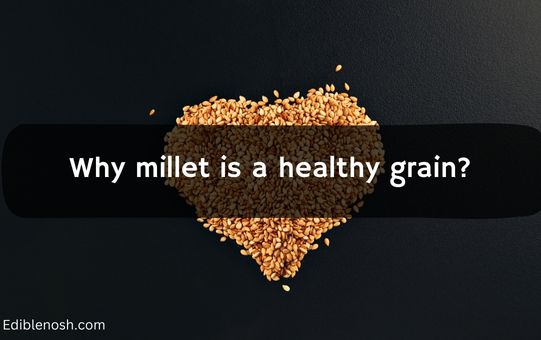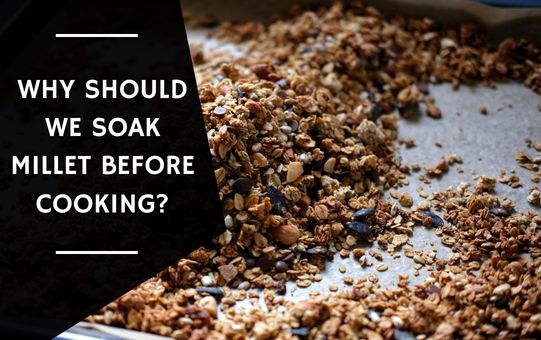Millet is often used as a staple food in many African countries because it’s highly nutritious and affordable. But Why should we soak millet before cooking?
Soaking millet before cooking improves texture, enhances flavor, increases nutritional value & makes it more digestible, making it a healthier choice.
In this blog post, we’ll explain why soaking millet is important, then teach you how to soak millet before cooking it.
Contents
Why should soak millet before cooking matter?
There are numerous advantages to soaking millet before cooking it. First, it can improve the millet’s texture. Without soaking, millet can be difficult to chew and digest.
Soaking millet allows it to absorb water, soften, and become easier to chew and digest. This can make it more palatable for individuals who have difficulty digesting grains.
In addition, soaking millet can enhance its flavor. Before soaking, millet has a mild, nutty flavor, but after soaking, its flavor becomes sweeter and nuttier. The process of soaking millet helps to release its inherent sweetness, making it a more flavorful cooking ingredient.
The nutritional value of millet can be improved by soaking it before cooking. Soaking millet aids in the breakdown of phytic acid, an anti-nutrient that can inhibit the absorption of minerals such as iron and zinc. By neutralizing the phytic acid, millet becomes more easily digestible, allowing for enhanced nutrient absorption.
Lastly, it makes millet more digestible for individuals who have difficulty digesting grains. The complex carbohydrates in millet are broken down through soaking, making it easier for the body to digest. It also reduces levels of lectins, which are proteins that can cause inflammation in the digestive tract.
Read Also: Why Should We Eat Millets?
Reasons Soak Millet Before Cooking
The following are the reasons for soaking millet before cooking:
- Improving Texture: Soaking millet prior to cooking can enhance its texture. Without soaking, millet can be difficult to chew and digest. Soaking millet softens the grains, making them easier to chew and digest. This also makes it more palatable for individuals who may have difficulty digesting unsoaked grains.
- Enhancing Flavor: The flavor of millet can be enhanced by soaking it. Before being soaked, millet has a subtle, nutty flavor. However, after soaking, the millet takes on a sweeter, nuttier flavor. The process of soaking millet helps to release its inherent sweetness, making it a more flavorful cooking ingredient.
- Increasing Nutritional Value: Additionally, soaking millet prior to cooking can increase its nutritional value. Soaking millet aids in the breakdown of phytic acid, an anti-nutrient that can inhibit the absorption of minerals such as iron and zinc. By soaking millet, the phytic acid is neutralized, making it more easily digestible and facilitating better nutrient absorption.
- Making Millet More Digestible: The process of soaking can also make millet more digestible for individuals who have difficulty digesting grains. The complex carbohydrates in millet are broken down through soaking, making it easier for the body to digest. In addition, soaking can reduce the levels of lectins, which are proteins that can cause inflammation in the digestive tract.
- Soaking Time and method: Depending on the recipe, millet should be soaked for a minimum of four hours and preferably overnight. Simply place the millet in a bowl and cover it with water to soak it. Ensure that you use approximately 3 cups of water per 1 cup of millet. Before cooking, the millet must be thoroughly drained and rinsed after soaking.

How to soak millet?
Soaking millet is a simple process that can be done in a few easy steps. Here’s how to soak millet:
- Determine the amount of millet you will need for the recipe. A good rule of thumb is to combine millet with water in a ratio of 3:1. Using 1 cup of millet, for instance, will require 3 cups of water.
- Cover the millet with the specified amount of water in a bowl.
- Allow the millet to soak for at least 4 hours or overnight. Soaking millet overnight will yield the best result in terms of texture and nutritional value.
- After the millet has soaked, drain and thoroughly rinse it before adding it to your recipe.
- At this point, the millet is ready to be cooked. Prepare the soaked millet according to your recipe after rinsing it.
It is important to note that some recipes may not require soaking, so it is best to adhere to the recipe’s instructions. Also, if possible, use filtered or spring water when soaking millet, as tap water may contain chlorine or other chemicals that alter the flavor of the millet.
Why millet is a healthy grain?
Millet is a healthy grain for a number of reasons. Here are several reasons why millet is a healthy food option:

- Gluten-free: Millet is naturally gluten-free, making it a great alternative for those who have celiac disease or gluten intolerance.
- High in Fiber: Millet is naturally gluten-free, making it an excellent substitute for individuals with celiac disease or gluten intolerance.
- Rich in Minerals: The high fiber content of millet can promote healthy digestion and prevent constipation. Additionally, it helps to regulate blood sugar and reduce cholesterol.
- Low in calories: Millet is low in calories, making it an excellent option for weight management.
- Good source of Protein: Millet is a good source of plant-based protein, which is important for building and repairing muscles and tissues.
- Provides essential amino acids: Millet is an excellent source of plant-based protein, which is essential for the development and maintenance of muscles and tissues.
- Can help prevent chronic diseases: Regular consumption of millet, due to its high nutrient content, may help prevent chronic diseases such as heart disease, diabetes, and certain types of cancer.
- Can improve gut health: It is rich in dietary fibers, which promote the growth of beneficial bacteria in the gut, thereby improving gut health overall.
- Easy to digest: It is rich in dietary fibers, which promote the growth of beneficial bacteria in the gut, thereby improving gut health overall.
Read Also: How To Tell If Millet Is Bad?
Final thought
Soaking millet before cooking can greatly improve its texture, flavor, and nutritional value. Additionally, it can make millet more digestible for people who may have trouble digesting grains.
Soaking time and method are simple, and the next time you’re planning to cook millet, consider soaking it first. You may find that it improves the overall taste and texture of your dish, and provides additional nutritional benefits.
FAQs | Soak Millet Before Cooking
Here are the following FAQs related to soaking millet before cooking:
How Long Should I Soak Millet Before Cooking?
Millet should be soaked for at least 4 hours or overnight for best results. The longer you soak the millet, the more the texture and nutritional value will improve.
Is It Necessary To Soak Millet Before Cooking?
It is not necessary to soak millet before cooking, but it is recommended as it can improve the texture, flavor, and nutritional value of the millet.
Can I Soak Millet For Too Long?
Yes, if you soak millet for too long it can become mushy and lose its texture. It’s best to stick to the recommended soaking time of 4 hours or overnight.
What Is The Ratio Of Water To Millet When Soaking?
The ratio of water to millet is 3:1. For every 1 cup of millet, you should use 3 cups of water.
Can I Soak Millet In Something Other Than Water?
Yes, you can soak millet in other liquids such as coconut milk, nut milk, or fruit juice for added flavor. However, you should make sure that the liquid covers the millet by 3-4 inches and use enough liquid based on the millet-to-liquid ratio.

